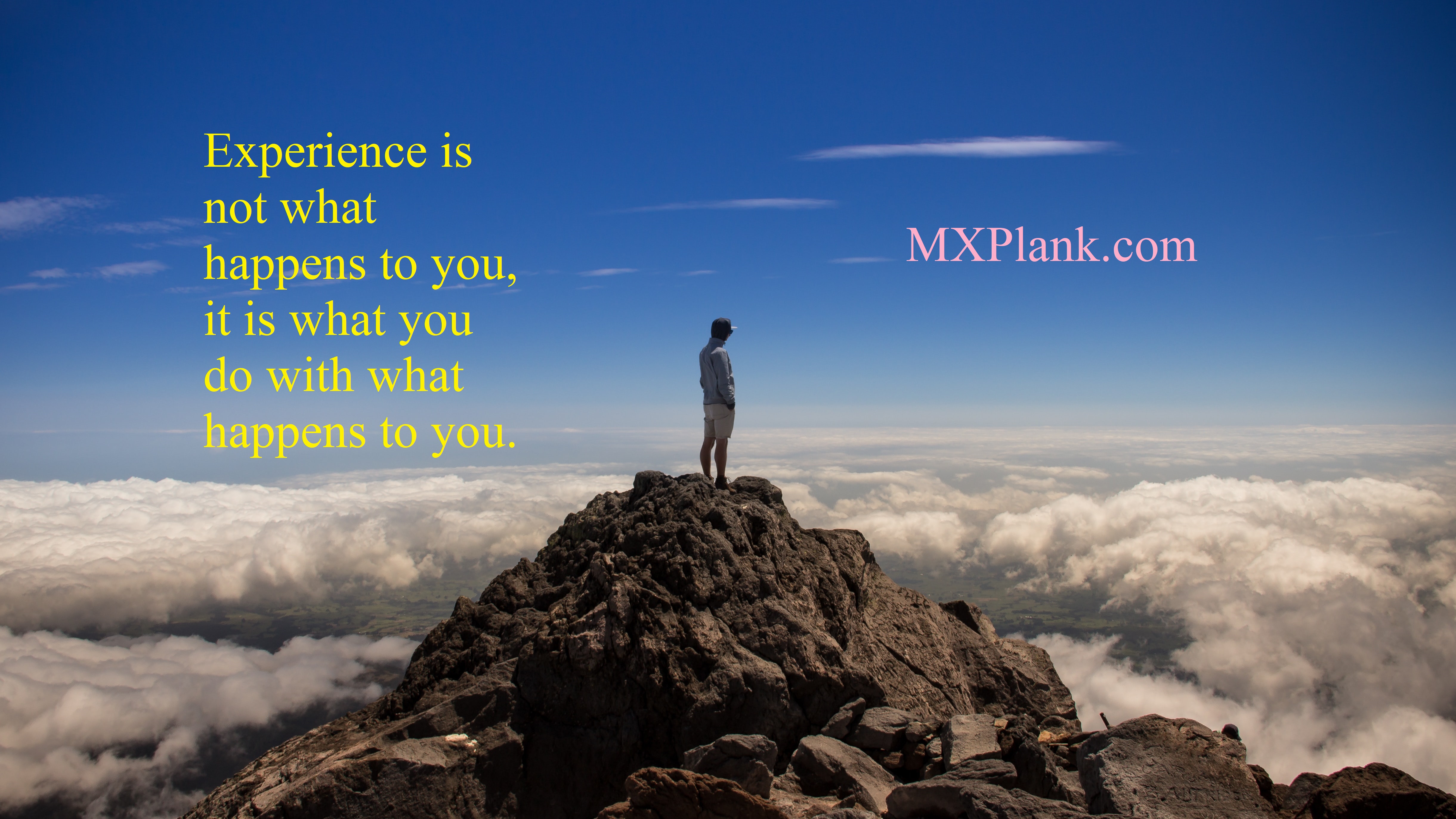Experience is not what happens to you, it is what you do with what happens to you

What is experience-based learning?
Experiential learning is a well-known model in education. Kolb's Experiential Learning Theory (Kolb, 1984) defines experiential learning as "the process whereby knowledge is created through the transformation of experience. Knowledge results from the combination of grasping and transforming experience."
A diagram of Kolb's cycle of experiential learningKolb's Experiential Learning Theory presents a cycle of four elements
Concrete Experience
Reflective Observation
Abstract Conceptualization
Active Experimentation
The cycle begins with an experience that the student has had, followed by an opportunity to reflect on that experience. Then students may conceptualize and draw conclusions about what they experienced and observed, leading to future actions in which the students experiment with different behaviors. This begins the cycle anew as students have new experiences based on their experimentation (Oxendine, Robinson and Willson, 2004) . Although this continuum is presented as a cycle, the steps may occur in nearly any order. This learning cycle involves both concrete components (steps 1 and 4) and conceptual components (steps 2 and 3), which require a variety of cognitive and affective behaviors
The Essential Components of Experience-Based Learning
Andresen, Boud and Choen (2000) provide a list of criteria for experience-based learning. The authors state that for a project to be truly experiential, the following attributes are necessary in some combination.
The goal of experience-based learning involves something personally significant or meaningful to the students.
Students should be personally engaged.
Reflective thought and opportunities for students to write or discuss their experiences should be ongoing throughout the process.
The whole person is involved, meaning not just their intellect but also their senses, their feelings and their personalities.
Students should be recognized for prior learning they bring into the process.
Teachers need to establish a sense of trust, respect, openness, and concern for the well-being of the students.
Some examples of experience-based projects include role playing, service learning, internships, studying abroad, open-ended projects (guided discovery), group projects and field study. The more open-ended and non-formulaic an assignment is, the more likely students will rely on their own experience and reflection and immerse themselves in the topic. Environmental subjects are especially suited to experience-based learning because humans play a role in just about every environmental issue. Thus using an experience-based approach to an environmental topic invites students to examine their own effects on the environment, whether positive or negative. Once students have become concretely aware of the ways in which they impact their environment, they can reflect on that and experiment with different environmentally-conscientious behaviors
Ways To Create Learning Experiences That Work:--
How many times have you completed a training exercise, returned to the job to apply your new knowledge and thought, "Wait, how do I do this again?" The time spent partaking in the learning experience seems unjustified when retention rates plummet and job performance wanes.
Keeping a list of best practices in instructional design on hand will allow you to design learning experiences that get the job done - that is, change behaviors and improve performance on the job. Here's a short list:
How To Create Learning Experiences That Work:--
Build In Daily Practice:
No one ever mastered a skill on the first try. Understanding concepts, definitions, and theories does not equal capability. If this were so, doctors would skip a residency program and jump straight to treating patients without supervision. Why shouldn't they? Four years of grueling medical school should have prepared them for the real world, right?
Ask any first year surgical resident whether they feel ready to take the lead in an open heart surgery. Ask yourself if you want a first year surgical resident taking the lead in your open heart surgery. Practice, yes, even for physicians, is key to capability. Practice is so important, in fact, that physicians have numerical targets to hit prior to graduating residency. At the University of Minnesota, OB/GYN residents must complete 200 deliveries, 150 C-sections, and 110 hysterectomies (though they all perform many more) before finishing residency.
Encourage Social Learning:
Social learning means information sharing. Information shared is information repeated, and repetition increases retention. Small group exercises, on-the-job mentoring and learning networks, whether formal or informal allow learners to bounce questions and ideas off one another, creating learning experiences that foster memorability.
Break Learning Into Chunks:
Learning can be overwhelming when viewing the big picture. Breaking down information into digestible chunks or microlearning allows learners to master a section before moving on. Eventually, the chunks create the whole. Structure your learning experience so learners complete small segments at a time
Focus On One Topic At A Time:
No matter how hard we try, the brain cannot actually multitask. People who believe they are multitasking are actually switching between two tasks very quickly. Whenever this switch occurs, a cognitive switching penalty takes place. Basically, the brain wastes time and loses information while rebooting. Create the learning experience to allow learners to have a singular focus
Make Learning Visual:
Vision trumps all other senses in learning. This doesn't mean throw all information up on a PowerPoint. It does mean that utilizing video, posters, flow charts, flash cards, and other visual focal points will keep your learner engaged. If in the classroom, consider providing your learners with highlighters, pens and pencils to color code or recreate visuals by hand they've seen during the learning experience.
Learn In Context:
A study was conducted with two groups of scuba divers. One group was tasked with learning a list of words on the beach, the other studied a list of words while underwater. The different groups were then tested in the context of where they learned the information and also where the other group studied. Those who were tested in the environment where they learned the information outperformed the other group.
With this in mind, classroom training isn't always appropriate, especially when learning new software. Seek to create learning experiences that reflect the environment the learner will use the information in. Often this may require a blended learning solution.
Use Spaced Repetition:
As you probably remember from high school, cramming doesn't produce long term results. To ensure long term retention, spread out your learning. Studies have shown that recall improves when learners take a break during tasks. As a general rule, it's better to study, or partake in a learning experience for 20 minutes a day, than for two hours one day a week. Avoid the knowledge dump.
Invest In Temporary Loss:
Learning a new skill will undoubtedly result in a period of poor performance, at first. When Josh Kaufman learned how to type on a new keyboard, his typing speed got worse before it got better.
When employees learn a new software system or process, it's very likely that there will be dips in productivity as they adjust. This temporary dip doesn't necessarily mean that the learning experience isn't working. Allow for this short-term dip (to a point), and as the learner becomes more competent, long term gains will outweigh short-term losses.
Focus On The Critical Components First:
The Pareto Principle states that for any event, 80% of the effects come from 20% of the causes. Learning speed can be increased by focusing on the critical 20% and by structuring the learning to accommodate. Work with a subject matter expert to identify the most critical information and structure the learning experience to cover these components first.
Prepare For Resistance:
The body and mind constantly seek equilibrium. When pushed out of balance, both attempt to auto-correct. This tendency is great during a crisis, but a negative force when encouraging positive change. Prepare for this resistance buy gaining buy-in on the front end. A short explainer video with testimonials from company higher ups will appeal to the heart of your learners. Remember "Heart, Head & Hands." Learners need to first believe learning can happen (heart). They need to understand what is happening, and why (head). And they need to know how to make it happen (hands).
Learn Towards A Goal:
Having a goal or business outcome that you're learning toward gives the information meaning and purpose. Learning for the sake of learning does not bring long-term results, and it's waste of time and money. Be constant in your focus, making sure the learner understands every minute spent in the learning experience is justified. Consistent reminders of the end goal will keep your learners motivated and moving forward.
Why is experiential learning important? ?
Today's world is dynamic and ever-changing. It's become widely accepted that children born at the late end of the 20th century and subsequent generations can expect to have around five careers over the course of a lifetime. Online classes and specialised skill workshops are becoming easy ways for employees to stay up-to-date with the latest trends and skills necessary to thrive in today's modern workplace. Because of this, increasingly employers are valuing soft skills in potential employees. For most industries, soft skills such as adaptability and empathy are considered just as valuable in a new employee as the skills and qualifications they hold.
Now more than ever, it is crucial that schools integrate new learning techniques to help prepare children for the future workplace. Rote and didactic learning styles have dominated the education system since the industrial revolution. With both these methods, the child plays a relatively passive role in the learning process. In more recent times, it has become common practice for teachers to integrate more active learning techniques in the classroom such as experiential learning.
What is experiential learning?
As the name suggests, experiential learning is the process of learning through experience. Experiential learning theory was initially proposed by psychologist David Kolb who emphasised how experiences influence the learning process. Kolb defined experiential learning as "the process whereby knowledge is created through the transformation of experience. Knowledge results from the combinations of grasping and transforming the experience."
In his experiential learning theory, Kolb described two different ways of grasping experience:
Concrete Experience
Abstract Conceptualisation
He also identified two ways of transforming experience:
Reflective Observation
Active or reflective experimentation
According to Kolb, concrete experience provides information that serves as a basis for reflection. From reflection, we assimilate the information we gathered through a concrete experience and develop new theories about the world which we then actively or reflectively experiment with. Kolb also noted that people who are considered "watchers" prefer reflective observation, while those who are "doers" are more likely to engage in active experimentation.
Experiential learning is becoming far more common in schools and educational institutes around the world. For example, Think Global School is a four-year travelling high school that holds classes in a new country each term. Students can engage in experiential learning through activities such as international travel, cultural exchanges, museum tours, and project-based learning.
What are the benefits of experiential learning?
Over the years, experiential learning has proven to have a wide range of benefits that contribute to a child's development.
Students can better grasp concepts:
Students may struggle to grasp concepts that don't pertain to the "real world." With experiential learning, students are given the opportunity to apply data and ideas in a real-world situation where they too play an active role. As the student interacts with the information, it becomes real to them.
Students have the opportunity to be more creative :
Experiential learning is one of the best ways to teach creative problem-solving. With real-world content, children learn that there are multiple solutions to challenges, and they are encouraged to seek their unique solution to hands-on tasks.
Students have the opportunity to reflect:
By incorporating concrete experiences with abstract concepts, and then reflecting on the outcome, students engage more regions of their brain and make stronger connections with the material. They are encouraged to analyse how their actions affected the issue, and how their outcome may have varied from other students'. This analysis helps them better understand how the concepts learned can be applied to other, varied circumstances.
Students' mistakes become valuable experiences:
As students engage in hands-on tasks, they will find some approaches work better than others. They discard the methods that don't work, but the act of trying something and then abandoning it - ordinarily considered a "mistake" - becomes a valuable part of the learning process. Students learn not to fear mistakes, but to value them.
Teachers often observe improved attitudes toward learning:
Experiential learning is designed to engage students' emotions as well as enhancing their knowledge and skills. Playing an active role in the learning process can lead to students experiencing greater gratification in learning.
How you can incorporate experiential learning in the classroom:
One of the easiest ways to ensure students are exposed to experiential learning is by incorporating off-site school trips and project-based learning into the curriculum. One example could be participating in a marine science workshop at your local aquarium or art workshop at your local art gallery.
A more comprehensive experiential learning opportunity would be an international school trip. International school trips give students the chance to experience a completely new culture and step outside their comfort zone away from the comfort of friends, family and familiar surroundings.






